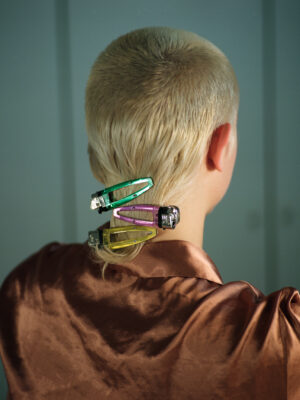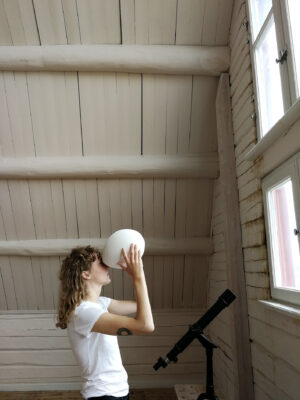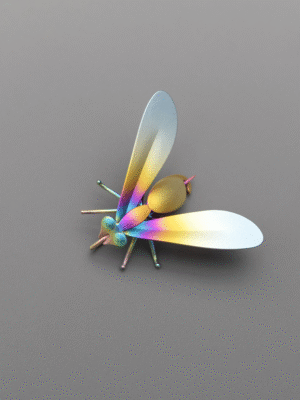But her signature piece is a distinctive disposable lighter/hair clip hybrid called ‘Lit Clip’, the success of which has significantly propelled her career since it was photographed on both Erykah Badu and Dua Lipa in 2021, gaining her the kind of publicity few experience.
Yet in a recent interview she reveals one of the more puzzling aspects to her commercial success, namely that it is partnered with the constant frustration of copycat versions of her design selling for a fraction of her price, and naturally, in a mass-produced form, to further insult the dedicated handwork of her original.
Seeking legal counsel, she is repeatedly told she has no recourse as her design was not copyrighted the minute she introduced it for sale. Beyond which, copyright law, almost exclusively administered by country, holds very little sway in the global marketplace of online sales.
So the question remains: What does intellectual property for artists look like? Can we really ‘own’ our own ideas, once they go to market? Corrina walks us through her story in what results in a reflection on the nature of jewellery itself.
Corrina Goutos: So basically, I designed this lighter hair clip in 2019.…it just came to me and it worked perfectly. I launched it in early 2020, to premiere at the CSM fashion show. I posted it and it immediately got circulated, ending up on the widest spanning sites you can imagine: this super metal, punk drummer’s fan page, and then this ultra girly Instagram as one of the Girly Must Haves of the year. Oh and my favorite: in 2021 there were a few memes of ‘Things that broke the Internet’, and my hair clip was in it.
And it was just so interesting to see how people were interpreting so differently.
The first thing that started to make me nervous: I found it on an Instagram page in California with legal marijuana and all these bongs and stuff, and they were like, ‘Coming soon: The Lit Clip’. They had it as a working lighter that they were like, ‘developing’, and they just posted my photos and said, Coming soon. And I just immediately wrote them on Instagram, like,
‘Excuse me.. You are not coming soon with this.’
The site in question did remove the offending content, giving her a temporary sense of control over her work online; bolstered by a sudden viral attention to the piece in the wake of purchases by first, Erykah Badu, then Dua Lipa later that year. The effect was swift and profound.
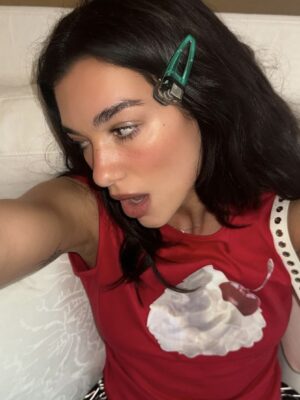
CG: That was enough to get, really, thousands of followers, and hundreds of sales, overnight. I was screwed. I was not at all prepared for the scale, and I was really crying in my studio…my fingers hurt, I didn’t know what to do.
I didn’t find any assistant or anything at the time, I made hundreds of hair clips by myself, and then delivered them very late. But it was crazy. I made my yearly income for the last several years in Germany, in like, one month.
___STEADY_PAYWALL___
Margaret Munchheimer: What level of making and selling and producing had you been at before that happened?
CG: It had been maybe 1,5 years that I was living off my art, and I had a very cheap life. So probably below the poverty line for mainstream society’s standards, but for me, I was getting by comfortably. Then when this happened, I went up tax levels, and I didn’t even know how to file this stuff. I didn’t have time to spend my money. I was really a whole different human being. And I didn’t identify with the celebrity status either and all these things that I don’t follow that I’m suddenly associated with; being reposted as the stylist of Dua Lipa, when in reality I’m like, I just had to google her.. So I wasn’t prepared to have a business of that scale, but the next year from her purchase was a super stable, good income.
MM: Did you hire anyone finally?
CG: My friends were there, holding my hand at one point or another, feeding me, but there just wasn’t the time. I couldn’t train someone even, in that moment, you know, like, I just had people do any other steps that they could do. By the time this started to calm down, I found someone, but by the time I had them, I didn’t have the sales and couldn’t afford them. So I’ve always had this really unlucky timing with that. It’s happened like, three, four times now.
So extreme… the internet! I mean, it’s always been the artist’s dilemma, but I think the internet makes it so much harder. It’s just massive spikes.
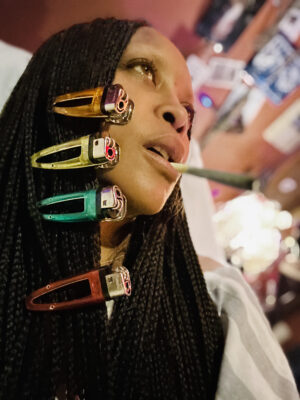
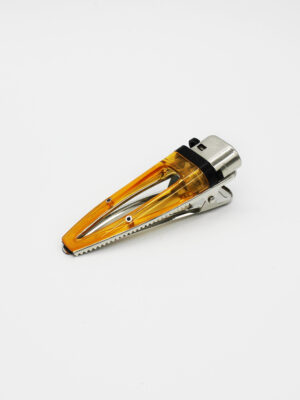
When what appeared to be a future of stable earnings ‘fell off a cliff’ in mid 2022, Corrina was left to find an explanation, simply assuming public opinion had grown tired of the work and moved its attention elsewhere. Until a chance encounter with Google Lens, when, jokingly scanning her piece on the app, she discovered multiple versions for sale that weren’t from her own hand.
CG: That’s how I discovered it, and I was in complete shock. My website and APOC were maybe first, but the third, fourth, fifth, were all these really weird, brand new websites and I realized, ‘Oh my God, that’s my hair clip.’
I’m seeing these customer ratings and reports and comments; it’s proper live and getting a lot of activity. The first comments are in mid 2022, and suddenly it made sense: Literally, the second that’s live, I stopped selling artwork. And, it’s 10% of the price, and half the photos are mine. Like, on my own head. The photo credits were even my name!
‘That was enough to get, really, thousands of followers, and hundreds of sales, overnight. I was not at all prepared for the scale, and I was really crying in my studio…’
When told by lawyers she consulted both in the US and the EU that she had no case, Corrina resorted to sending self-composed cease and desist letters to the brands in question, ultimately directing them to the copycat brand’s comment feed. Though they were never posted publicly, she reasoned, at least someone had to be reading them, if only to reject posting them, thereby putting the offenders on notice that she was aware of their piracy.
When the odd response came, it was generally in agreement to remove the piece, but provided she had a copyright.
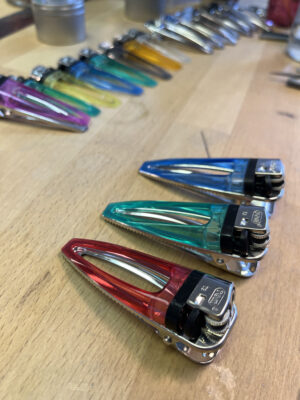
CG: But I didn’t. I don’t have a copyright, because lawyers have always told me at my scale, this is not affordable– that it is more money than I would ever have made with the design. But this is huge money for me; I’ve made thousands on this design, and I never had a breakdown from anyone [of the costs] they just basically told me it wouldn’t be for me.
In Europe, there’s Design Registration, which is something easier, but it doesn’t matter, because the people ripping me off are never in Europe.
MM: And that’s the issue, that in the places where these things are being produced, these types of laws don’t apply?
CG: There’s nothing that protects you everywhere, which is crazy. Nowadays, everything is everywhere, it’s a globalized economy. I mean it’s so outdated, it’s really not, not relevant to internet times.
While the jury may be out in Corrina’s case, the search for existing global Intellectual Property (IP) protection for design and artworks is murky territory, often yielding confusing or inconclusive information. Costs vary widely, and protection is often partial depending on the provider. For example, the EU Registered Community Design which is indeed only valid in the EU, has a base registration fee of €350, and must be renewed every five years. Whereas, the World Intellectual Property Organization details a more robust protection specifically for design, called the Hague System, which covers roughly 90 countries under a modular fee structure based on the desired areas of coverage. It offers a one time registration and allegedly grants lifetime protection, but a hypothetical check on the fee calculator for a small business owner like Corrina, registering one design, in every available region, began at roughly €7000. The financial reality for most makers would make this a big step indeed, and one that many would forego. Not to mention the fact that actual prosecution can be lengthy and expensive, even with a registered copyright in place. All in all, it’s easy to see how a working artist can find themselves without an easy answer to the situation.
MM: Where do you go from here?
CG: To fight back for my autonomy, and find ways to feel less helpless in this process.
I considered engaging my community on social media, but then I thought of something I identified better with. Erykah Badu and I had been texting directly, so I reached out to her explaining the situation. Her purchase had been such an encouraging celebration of my work’s originality and value at the time, and she remained a strong and sympathetic advocate. Posting a tagged series of photos wearing her whole collection, she offered her position of power to emphasize that ‘Lit Clip’ was associated with me and me only. This granted me another wave of reach, aiding me in recovering some of my due credit.
‘There’s nothing that protects you everywhere, which is crazy. Nowadays, everything is everywhere, it’s a globalized economy… it’s really not relevant to internet times.’
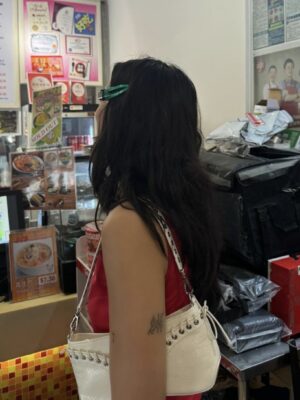
This approach of leaning into the exposure proved itself again the following January, when Selfridges commissioned 100 hair clips for their pop up and expo, The Joke Shop; excellent promotion as well as the legitimizing support of big name acknowledgement. And indeed interest in the piece continues to grow.
Beyond this, the artist is quick to point out, she isn’t just an accessories manufacturer, but maintains an extensive art practice of exhibition and installation work, which she has never relegated to a separate brand. Periodically halting production for more in depth artistic pursuits is par for the course, such as her upcoming residency at Francoise van den Bosch in Amsterdam in early 2025. This ability to maintain her artistic practice amidst doubt, uncertainty and commercial pressures proves a source of strength for Corrina.
CG: You know, something we have to say, it is a kind of rite of passage; in a way, there is some flattery to it as much as it hurts. Any brand that would be sold in Selfridges at scale is going to have rip-offs in the world, but at least people are willing to pay and acknowledge the craftsmanship that goes into that.
And you never know. There were definitely different waves on the internet over the years, where it took off again- like when it first reached those on Tiktok, the Instagram wave three years prior… I could imagine another viral wave.
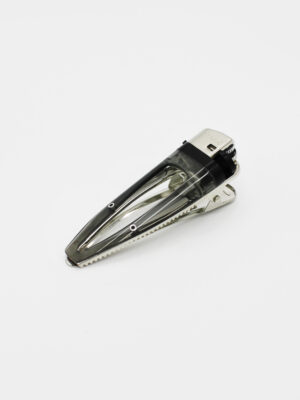
Corrina’s story raises so many questions, not just about intellectual property, but about how to work on a manageable scale while producing unique, handmade work, particularly in times of both greater and lesser success. As well as how artists can protect themselves against the financial precarity that the unpredictable nature of the internet seems to intensify.
And, with our primary marketplace an ecosystem still in development, who can advise us on how to have successful, long term careers, when the format itself hasn’t been around long enough to yield long term results?
In the contemporary jewellery context, with its oft-referenced but seldom explained “taboo” on commercial success, do we even have role models within the field to demonstrate what success looks like in a post-gallery context? In this respect, makers such as Corrina would appear to stand in a pioneering position; elders of the future with no elders of their own.
What remains intriguing is the relationship of the internet as a mediator of exposure. It promises such rewards, while increasingly opening us to vulnerability of our artistic agency- yet the only cure seems to be more exposure. Until the legacy of what we have created is so saturated, so complete, that there can be no doubt of the provenance of our works. Can we not find a contemporary approach to creative work that serves the working artist of today, beyond the wildly abstract models of NFT’s and $6 million bananas?
In a fitting follow up, the most recent viral wave saw Corrina crafting the ‘Lit Clip’ in a process video for I-D magazine’s DIY series, in late November, painstakingly documenting the labour intensive process behind her now iconic piece. It is both a nod to her as an artist and a coveted moment of personal identification with the work– a testament to her agency.
In a moment of reflection from atop the wave, she muses that it is the nature of jewellery, to go into the world and choose for itself where it will make its mark, regardless of the expectations of its maker.
CG: It’s never finished in the sense that, where it ends up is never determined, and doesn’t like to be determined, at least not by the jeweller. You just hope it finds its way in the world, and [if] it tells me it wants to be a mainstream pop superstar, well, all I can say is ‘I’m so happy for you Lit Clip…Wherever you wanna go, I love and support you.’
This article is part of a larger exploratory series called Future Legacy, commissioned by Current Obsession. This theme intertwines sustainability and social change, including a narrative of respect, ceaseless innovation, mentorship, and community. Future Legacy celebrates our collective past while inspiring a socially responsible, sustainable, and inclusive future.
Corrina Goutos, a New York State native, now located in Hamburg, Germany, is an Artist working in Jewelry, Objects and Installation. Working to breakdown the hierarchy of man and material, Goutos interdisciplinary practice is considerate to the political ecology of human and non-human materials. Here beloved and forgotten objects mingle and co-create, be it by the agency of the artist or by nature herself.
Margaret Munchheimer is a practicing goldsmith, freelance editor, copywriter and interview journalist, and producer of ‘The Big Playback’, a podcast about all things music.
All featured images are the courtesy of Corrina Goutos.
